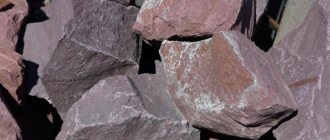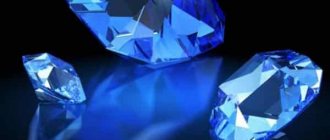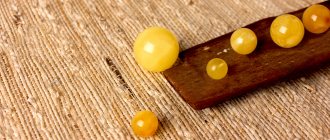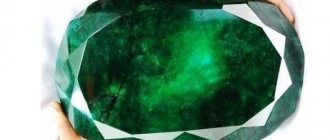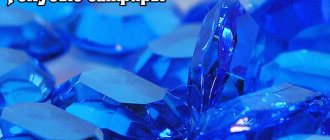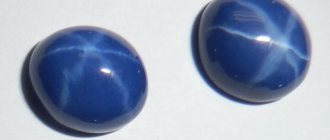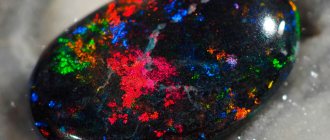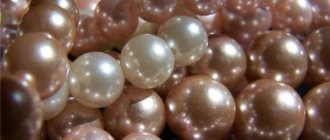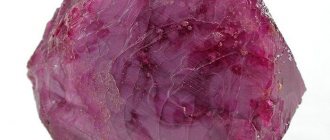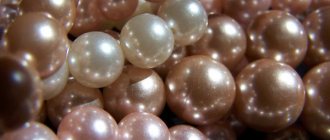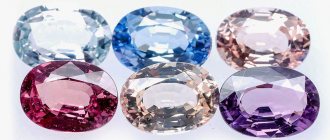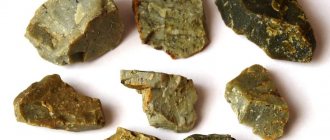Many people associate synthetic stones with fake. In some cases this is true. But you need to know the difference between synthetics and imitation. Any minerals of both natural and artificial origin that only resemble stone can act as imitation. What technologies are used to create it, and where is artificial sapphire used?
Synthetic minerals have different requirements. They must not differ in all characteristics from the original. Therefore, most often, when making grown stone, they try to repeat the processes that occur in nature.
Description of artificial sapphire
Synthetic sapphire is obtained artificially.
This sapphire has an even color and bright shine. There are no chips, cracks, natural inclusions or other defects that natural gems have. In mineralogy, sapphires are stones that are exclusively blue in color. Sapphire corundums can be either transparent or colored in different colors, mainly blue and dark blue.
Nanosapphire is not afraid of temperature effects, ultraviolet rays, and lends itself well to cutting. When selling jewelry with such a stone, it must be marked “g/t” or “synthetic,” indicating the artificial origin of the stone. If the mark is missing, the seller is breaking the law by selling artificial stones under the guise of natural minerals.
Varieties and colors
Synthetically produced stone is colorless. It is called leucosapphire. The high strength, heat resistance, and transparency of the mineral allow it to be used in industry in the production of microcircuits, LEDs, and screens in mobile devices.
In jewelry, colored varieties of corundum are more often used. The most common sapphires are blue and light blue, because... they more faithfully imitate the original.
Other shades are also available:
- pink;
- orange;
- yellow;
- green;
- violet;
- black.
In jewelry, there are various shades of sapphires.
Scientists have learned to grow synthetic star sapphire. This stone creates an unusual optical effect.
When illuminated, a light spot with rays diverging in different directions can be seen on the surface of the gem.
How crystals are grown
There are several main methods by which synthetic sapphire is grown. For a long time, manufacturers acted according to the Verneuil method, which consisted of several stages:
- Powdered alumina with additions of titanium and iron oxides was placed inside a special hermetically sealed burner with a ceramic muffle.
- Heating occurred at high temperatures and pressure, accompanied by melting of the powder and then settling on the pin.
- The growth of a conical-elongated boule (growth) began.
To grow higher quality artificial sapphire, the alumina powder must be fine-grained, dry, and able to “flow” easily. If the grains are large, then the viscosity of individual sections increases, which leads to distortion of the shape of the boule and deterioration of its internal structure. This is how they even learned to produce specimens with the asterism effect.
The second method of growing sapphires artificially is hydrothermal. Its essence is as follows.
- Instead of powder, a seed of natural colorless corundum is used. It is very small, but it is on it that the crystal grows.
- Next, a saturated solution is prepared containing aluminum ions, as well as chromophoric elements (“dyes”). The seed is lowered into it.
- The starting materials are placed in a special autoclave, which is capable of maintaining high temperatures (300-600 ℃) and pressure (up to 1.5 Kbar).
- As a result, conditions similar to natural ones are created. The growth of a synthetic (“cultured”) crystal begins from the solution on the seed.
The resulting material is of high quality: transparent, evenly colored, but including the smallest bubbles. They are characteristic of this technology, although they practically do not affect the purity of the stone.
The third method is the Czochralski method, which is based on “pulling” a substance from a melt placed in a refractory crucible. The seed, lowered into the melt, gradually rises, and sapphire is deposited around it.
At temperatures above 1750℃, diffusion treatment of the grown raw materials with iron and titanium is applied to obtain a blue color. Beryllium gives other shades to the crystal, for example yellow.
History of creation
The first attempts to create artificial sapphire were made by the French chemist Auguste Verneuil in 1886. After 16 years, he managed to obtain a single crystal by melting metal oxides in a burner fire at a certain temperature and then cooling them.
Later, Verneuil's home laboratory turned into industrial production, which began to produce up to 3 tons of corundum per year. This method of producing artificial stones, called the Verneuil method (process), is still used to this day.
First attempts at synthesis
Synthetic sapphire was first obtained by the French chemist Verneuil in 1904. To do this, he used a method he himself invented: he placed the finely ground mixture in the flame of a hydrogen burner. Verneuil's method quickly found wide application and is still used almost unchanged today. But it's not perfect, so the experiments continued.
In 1916, Polish chemist Jan Czochralski came up with a method for growing crystals from a melt. According to legend, he dropped a pen into a crucible of molten tin, and when he took it out, he noticed that a thin thread of hardened metal was trailing behind the pen. It turned out that it has a monocrystalline structure. The chemist developed a method for the synthesis of other single crystals, which was later called the Czochralski method.
The first hydrothermal sapphire was created almost 60 years ago by two researchers - Laudise and Balman. They managed to obtain a high quality colorless stone. And several decades later, scientists from Novosibirsk selected a dopant based on divalent nickel, achieving a uniform “sky blue” color of sapphire. Since 1995, the technology began to be used for industrial purposes, and was later supplemented and expanded.
Methods for producing artificial crystals
Nanosapphires are synthesized on an industrial scale around the world. In addition to the Verneuil method, other technologies are also used.
The Kyropoulos method is based on growing corundum from molten aluminum oxide. The seed crystal is immersed in a liquid medium, where its growth begins with the help of heating. It is gradually pulled out of the melt, continuously rotating around its axis.
Synthetic sapphires are synthesized all over the world.
Other methods for producing sapphires from melt (Czochralski, Stepanov) are based on moving a crystal or container in a temperature gradient field. With this method, the temperature values of the melt are equal to or slightly higher than the melting point. The lower part of the seed crystal is constantly in contact with the melt. The crystal grows down around the seed and is pulled out into a monolithic cylinder.
Method of making sapphire
There are 2 ways to obtain synthetic sapphire in the laboratory:
- A mixture of starting materials (aluminum oxide and color additives) in powder form is poured into a vibrating hopper with special holes. The powder spills into the furnace through tubes from the holes, while oxygen and hydrogen are supplied at the same time. When hydrogen burns, it melts the mixture and a crystal begins to grow.
- Nano-sapphires are grown using aluminum oxide as a base. To do this, the seed plates are placed in special devices where the required pressure and temperature up to 5000 °C are maintained.
Watch a program about growing stones in a special factory:
Post-cultivation treatment
To prevent cracking, the resulting sapphires are subjected to post-growth annealing in special installations. Subsequently, they are given the desired shape using laser grinding and polishing with suspensions and pastes. Due to the fragility of the material, processing using lathes, drilling and grinding machines is not used.
Synthetic sapphires are colored and refined using various technologies: diffuse treatment with metal salts, heating, and ultraviolet irradiation.
Properties of artificial sapphire
Artificially grown corundum is similar in appearance to real stone and has an identical crystal structure. It has high strength and high shine. The degree of transparency of stones can vary: from transparent colorless (leucosapphire) to opaque black.
Physico-chemical
The main structural element of synthetic corundum is aluminum oxide. The relative surface hardness value is 9 points on the ten-point Mohs scale. Density - 3.93 g/cm³. Melting point is above 2000 ºC. The mineral reacts chemically with acids and dissolves in them.
Aluminum oxide is the main structural element of sapphire.
Medicinal
Like many gems, sapphire has medicinal properties and is used in alternative medicine. It affects both the physical and spiritual state of a person.
It is believed that the mineral helps with diseases of the musculoskeletal system and diseases of the circulatory system. Wearing amulets with this stone improves vision and hearing, and helps get rid of skin pathologies. Constant contact with sapphire improves mood, reduces symptoms of apathy and depression, and relieves insomnia.
Magical
Blue corundum is a symbol of fidelity, chastity and modesty. It helps its owner find love and improve relationships with a marriage partner. Sapphire is a protector from negative otherworldly phenomena: the evil eye, damage, love spells. It also protects from the influence of envious people, gossips and slanderers. The gem gives determination and courage to an insecure person.
The mineral is believed to have powerful positive energy. It helps to develop the best human qualities: kindness, responsiveness, compassion. It gives inspiration to creative people and stimulates them to search for non-standard approaches to implementing projects.
Blue corundum will protect against the evil eye and damage.
Blue sapphire is the main symbol of the 45th wedding anniversary.
On this day, spouses exchange wedding rings with inserts made of this mineral.
Nano sapphires, nano emeralds and zodiac signs
Compatibility of nano sapphires and nano emeralds with zodiac signs:
- Synthetic emerald has great strength and energy. It should not be worn by zodiac signs such as Capricorn, Virgo, Libra and Aries. For Scorpios, this stone can bring very big troubles. Nano emerald is perfect for the Gemini zodiac. It will bring them good luck and fill them with energy. Aquarius should wear an emerald pendant, and the effect of the stone will be more powerful for this zodiac sign. Sagittarius will gain mutual understanding with the outside world and harmony with themselves.
- Nano sapphire is safe for zodiac signs such as Cancer, Libra, Pisces and Virgo. The stone helps to concentrate on thoughts and maintain composure in the most difficult situations. Scorpios should wear red and blue sapphires better. Libra works well with any color of sapphire. For Leos, the stone will help them find loyal friends and win the sympathy of their comrades.
Areas of application
In addition to the jewelry industry, nanosapphires are also used in other areas:
- Medicine . Leucosapphires are used as a material for the manufacture of surgical blades, artificial eye lenses, optical elements of diagnostic devices, and braces in dentistry.
- Optical industry . Nanosapphire is a raw material for the production of large-sized optics, protective glasses, lenses, and prisms.
- Instrument making . The synthetic mineral is used as substrates for semiconductor microcircuits and optoelectronic devices.
- Laser technology . The mineral is used to produce titanium-sapphire lasers and amplifiers.
- Aviation and Rocket Science . The hard stone is used to make thin, impact-resistant glass for aircraft and space station windows.
In construction, sapphire is used to produce new generation thermal insulation materials.
Jewelry with synthetic stone
Artificially grown stones can reduce the cost of jewelry with inserts. In terms of their structure and physicochemical properties, they are complete analogues of natural minerals. Externally they are even superior to the original.
Jewelry with synthetic stones can reduce the cost of the product.
Natural rocks do not always have a smooth surface without cracks and foreign inclusions. Sapphire corundum is free from all these disadvantages: jewelry with such stones looks more attractive from an aesthetic point of view.
What to look for when choosing
When purchasing a product with sapphire corundum, you need to pay attention to the tag, which should indicate information about the artificial origin of the mineral. The stone is best viewed in good light under a magnifying glass. The crystal grown in the laboratory has an even color and is transparent. The only foreign inclusions that can be seen are air bubbles.
How to wear and care
Nanosapphires are durable and resistant to mechanical stress, so they do not require special care. When dirty, clean them with running water or soapy water, and then wipe with a soft cloth. It is better to store items with sapphires in a separate fabric bag, since due to the high strength of the stone they can damage other jewelry.
Corundums should not be thrown or dropped. Despite their hardness, microcracks may appear in them, which subsequently leads to destruction. Chips on the surface spoil the appearance of the products.
Nano sapphires, nano emeralds: what is it?
This is the name for jewelry that exactly replicates stones created by nature. They are increasingly used as a replacement for real stones due to their low price. This classification includes gems that were grown in a special laboratory.
These stones almost perfectly match real jewelry. They retain the same appearance, weight, and hardness. A distinctive feature from a regular fake is that it uses more advanced technologies for creation and uses more expensive materials.
The technology for producing synthetic stones is getting better. Only a specialist can distinguish such a product from a real one.
Doublets with natural sapphires
Doublets are composite stones made up of 2 layers. A thin plate of real sapphire forms the top layer, and an artificial mineral or a cheap imitation of it is glued underneath it. Doublets are often made from damaged stones when it is necessary to hide defects.
Doublets are made from damaged stones.
The glue is selected so that it matches the color of both the top and bottom layers. You can identify a doublet using a magnifying glass. It is enough to look at the stone from the side to detect the border between the two halves.
What can replace the real sample?
On the market you can find imitations of a natural sample, which can even be passed off as real. To distinguish a fake, you will need to use identification methods.
Common fakes
An artificial sapphire heats up quickly in the hand, while a real one will take a long time to do so. The most common materials used are glass or other similar materials.
Doublets
Or composite stones consisting of two or more layers. The main condition is that it hides damage well.
Artificial analogues
They are grown independently using special equipment. To give the required color, cobalt, nickel oxide, and magnesium are used.
Note! High-quality artificial stone can be superior to natural stone in a number of ways.
Other imitations of natural corundum
Synthetic corundum is a structural analogue of a natural crystal, but differs from it in the chemical composition and content of microimpurities. From an aesthetic and practical point of view, it is the most acceptable copy of natural sapphire.
Natural imitations of opaque sapphire include specimens obtained from waste natural stones by gluing or pressing. This group also includes colored natural minerals of other rocks.
Cheap fakes are made from glass alloys, which contain metal oxides to obtain the desired color.
Opaque stones are imitated using colored plastics.
Appearance of the gem
Sapphire is a subtype of corundum. Initially, this stone has different shades of blue, from bright blue to purple. There are also yellow, powdery, green and amber-colored gems. In terms of chemical components, it is aluminum oxide, the structure of which contains impurities of iron and titanium. It is due to these components that the stone has a rich blue tint. The mineral is distinguished by its rigidity and refractive power, which gives it a pronounced shine.
The unprocessed mineral is distinguished by its uneven outline and color intensity. It is processed using a variety of methods. The most common are the facet cut and the cabochon technique, which makes the surface of the mineral smooth and smoothes out the edges. The facet cut is different in that it can be used to give the stone a variety of shapes, for example, a heart, a triangle or an octahedron. It is this type that is most often used for processing star sapphires, the structure of which contains rutile. The most valuable gemstones are deep blue, the shade of which is close to cornflower blue. Pale blue and dark blue minerals are not valued as highly.
Attention! Red sapphires do not occur in nature. Corundum, which has a rich red and garnet hue, is called ruby.
How to distinguish natural sapphire from imitation
Only an expert can distinguish a natural sapphire from sapphire corundum or a skillfully made fake. In order not to make a mistake with your choice, you should purchase jewelry in reliable stores, check the labeling, and ask the seller clarifying questions.
It is difficult to distinguish natural sapphire from imitation.
The artificial origin of the stone can be revealed by microscopic air bubbles or dust particles that got inside the crystal during its growth. High-quality doublets are difficult to recognize, since the gluing area is often hidden by the frame.
Mechanical impact
The surface of natural sapphires, like their lab-grown counterparts, is free from scratches from sharp objects. It’s easy to scratch a cheap glass or plastic fake.
The place where the doublet is glued will appear more clearly if you immerse the stone in an oily liquid. In this case, the boundaries of 2 interconnected rocks will take on a different shade.
Official methods
Microscopic examination reveals differences between natural and artificial corundum. A growth structure uncharacteristic of natural formation is revealed by a synthetic stone. Titanium impurities are often added to nanosapphires, which give them a blue or blue color. Under the light of an ultraviolet lamp, the artificial analogue acquires a greenish tint, which indicates the presence of foreign impurities.
Features of artificially grown samples
Jewelry is rare in nature, which is why its value is constantly growing. The price of substitutes produced in laboratories is significantly lower. At the same time, only a professional can distinguish a fake from a natural gem. That is why synthetic analogues are in particular demand and popularity.
Externally, the synthetic mineral is also not very different from the natural one. And thanks to modern manufacturing technologies, the product can be given virtually any shade and saturation. Hydrothermal or nanosapphires are grown from scratch or made from corundum. You can give them the desired tone using coloring. The chemical component of natural and artificially grown pebbles is aluminum oxide. They also do not differ in Mohs hardness (9 out of 10 points).
Which sapphire is better to choose: natural or synthetic
Natural stones are several times more expensive than their synthetic counterparts. This is explained by the cost of products, which includes production and sales costs. Deposits of natural minerals are drying up every year. In addition, large resources are spent on mining gems, which also increases the final cost of jewelry.
Natural stones are very expensive.
The production of synthetic corundum is cheaper. But this does not mean that the stone obtained artificially is worse. It often looks more aesthetically pleasing than the original and has brighter colors. In structure and composition it is identical to natural minerals.
Mineral deposits
There are not so few sapphire deposits on the planet, but there are only two crystals with perfect or close to perfection:
- Kashmir (region of the Hindustan Peninsula). The rarest and most valuable stones of the perfect cornflower blue color are found there. There are very few of them (less than 5% of total production), so they are expensive.
- Sri Lanka (island in southern Asia). A little east of Hindustan, on a neighboring island, rare blue and pink sapphires, called “Ceylon”, are mined.
A large number of corundums (about a quarter) are extracted from the bowels of the Australian soil, but they are much inferior in quality to the first two options. Sapphire is found in smaller quantities in the USA and China, Thailand, Burma and Vietnam. As for Russia, there are no large deposits on its territory, although there are small quantities of sapphires in the Urals. They have a grayish tint.
This is interesting!
An unusual story happened in the sixties of the twentieth century with a young man from the USA, whose name was Steve Mayer. He and his friend often explored abandoned quarries and gorges. In one of these quarries near the small town of Canton, a man picked up a large blue sapphire crystal weighing 3,500 carats, but mistook it for rock crystal. He worked as a radiologist and found it very convenient to use the stone as a paperweight, until one of his patients advised Steve to take the stone to a jeweler, or better yet, a gemologist.
Advantages and disadvantages
Nanosapphires have their positive and negative sides.
The advantages of synthetic corundum include:
- smooth surface without cracks or foreign inclusions;
- saturated color;
- resistance to scratches, ultraviolet radiation, and most detergents;
- low cost.
The only disadvantages can be considered the laboratory origin of the stone and its ideal appearance. Awareness of authenticity is important to many people, so some imperfections in natural breeds will be an advantage for them.
Useful tips
You should choose jewelry with sapphires based on your own preferences and financial capabilities. Those who believe in the magical and healing properties of stones should purchase real gems. It is believed that only they have supernatural powers. When purchasing natural stone, you should ask the seller for documents confirming its authenticity.
People who value, above all, an attractive appearance and the absence of flaws in stones, are more suitable for artificial sapphires. Purchasing jewelry with such corundum is a good option for those who want to save money.
Types of artificial gems
It takes several thousand years to grow a natural gem, while scammers get a fake one in just a couple of weeks. You can also use faster methods. Existing inclusions can be called differently.
Fakes
Often scammers use regular ground glass that looks like sapphires. However, such stones will contain bubbles.
Doublets
In this case, a real sapphire is glued onto an artificial crystal, glass, or cheap gem. The difference can be seen under a magnifying glass.
Artificial stones
In order to be as close as possible to a natural stone, sapphire is grown using the Vernel, Chorhalski, and Zone melting methods. Source materials: titanium, chromium, natural corundum chips, iron, nickel and so on. The resulting samples are used in technology, medicine, rockets, and the jewelry business.
Other natural stones
The following minerals are similar in appearance to sapphire: spinel, kyanite, tourmaline, tanzanite, topaz.
